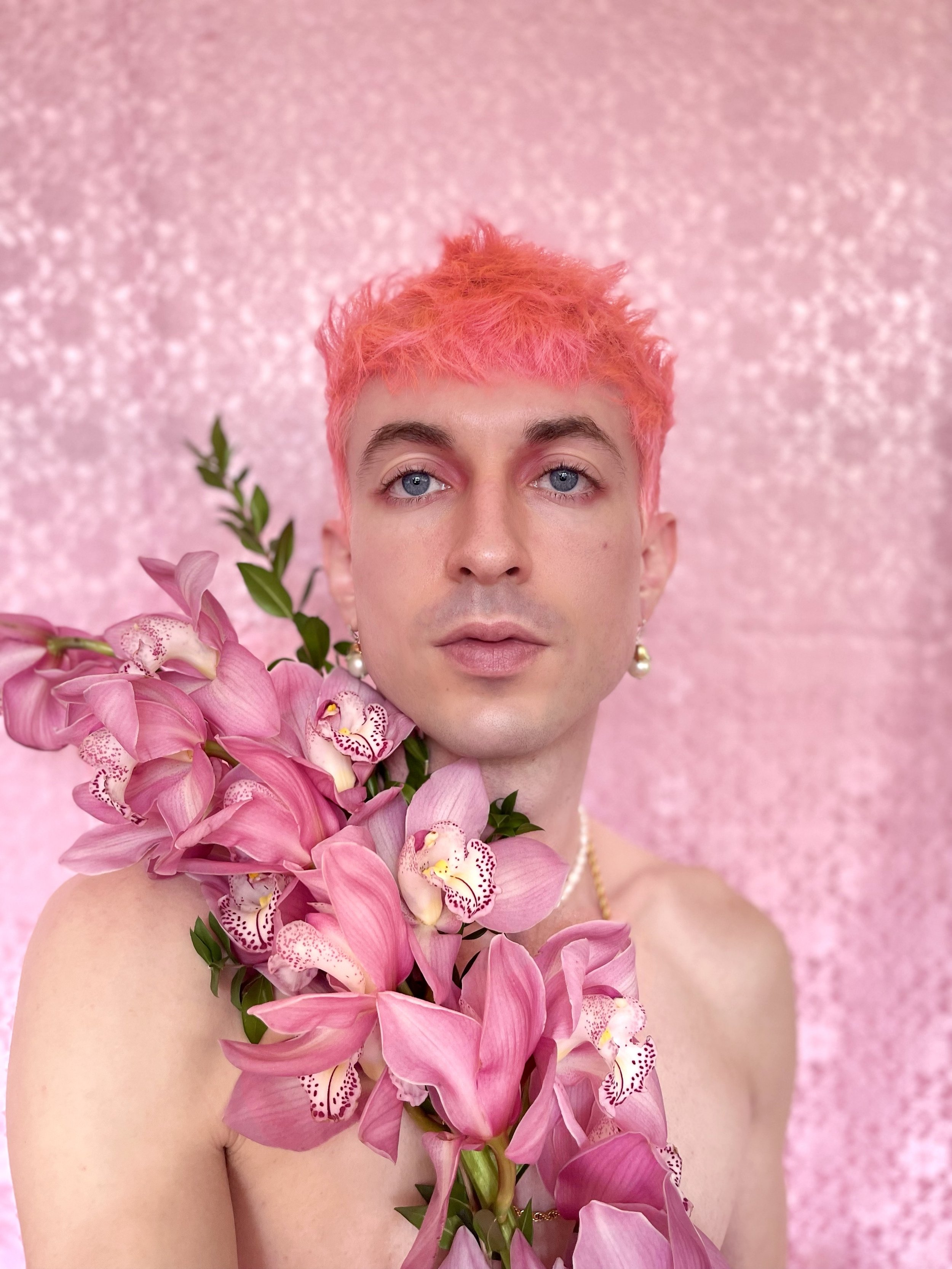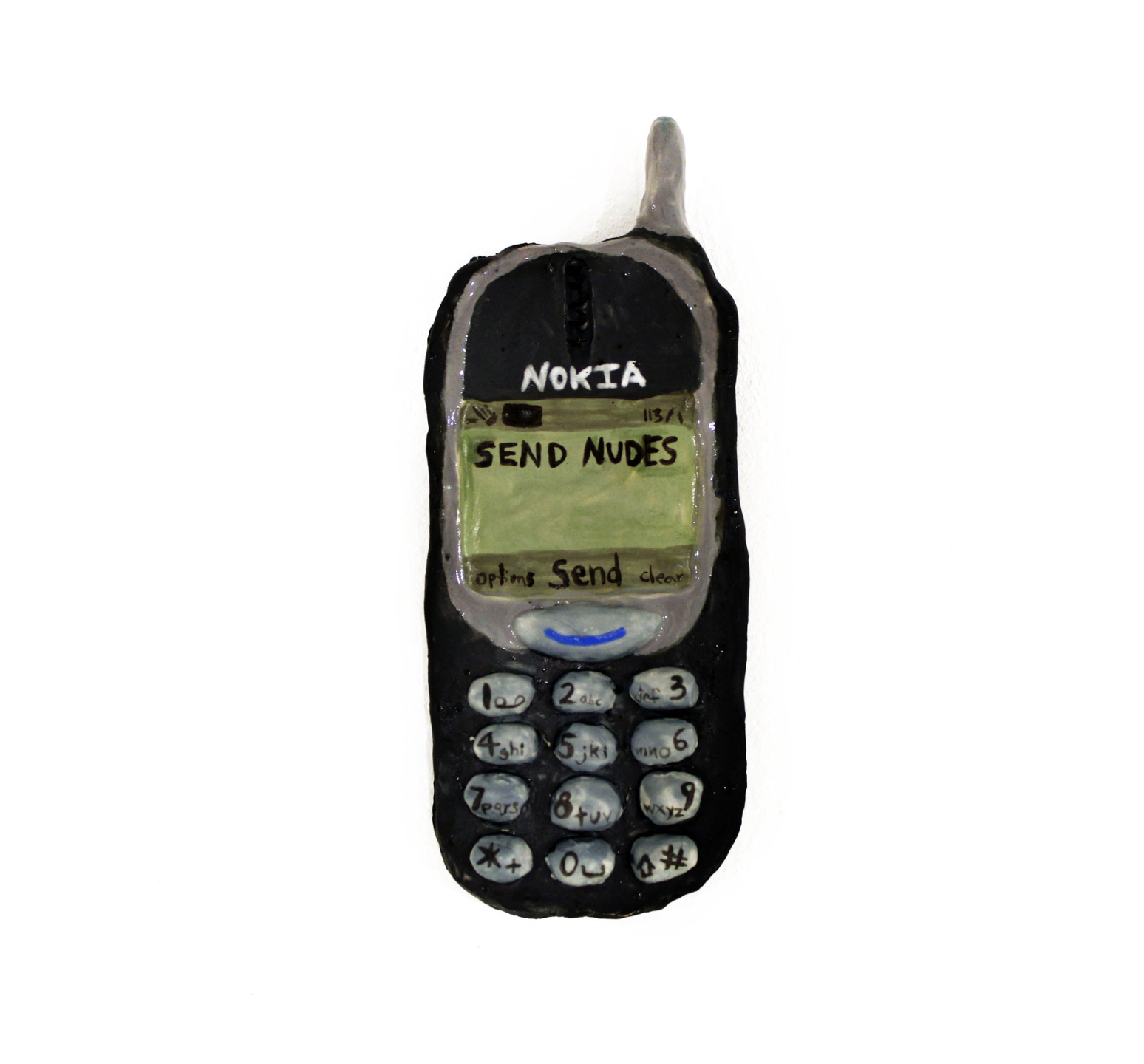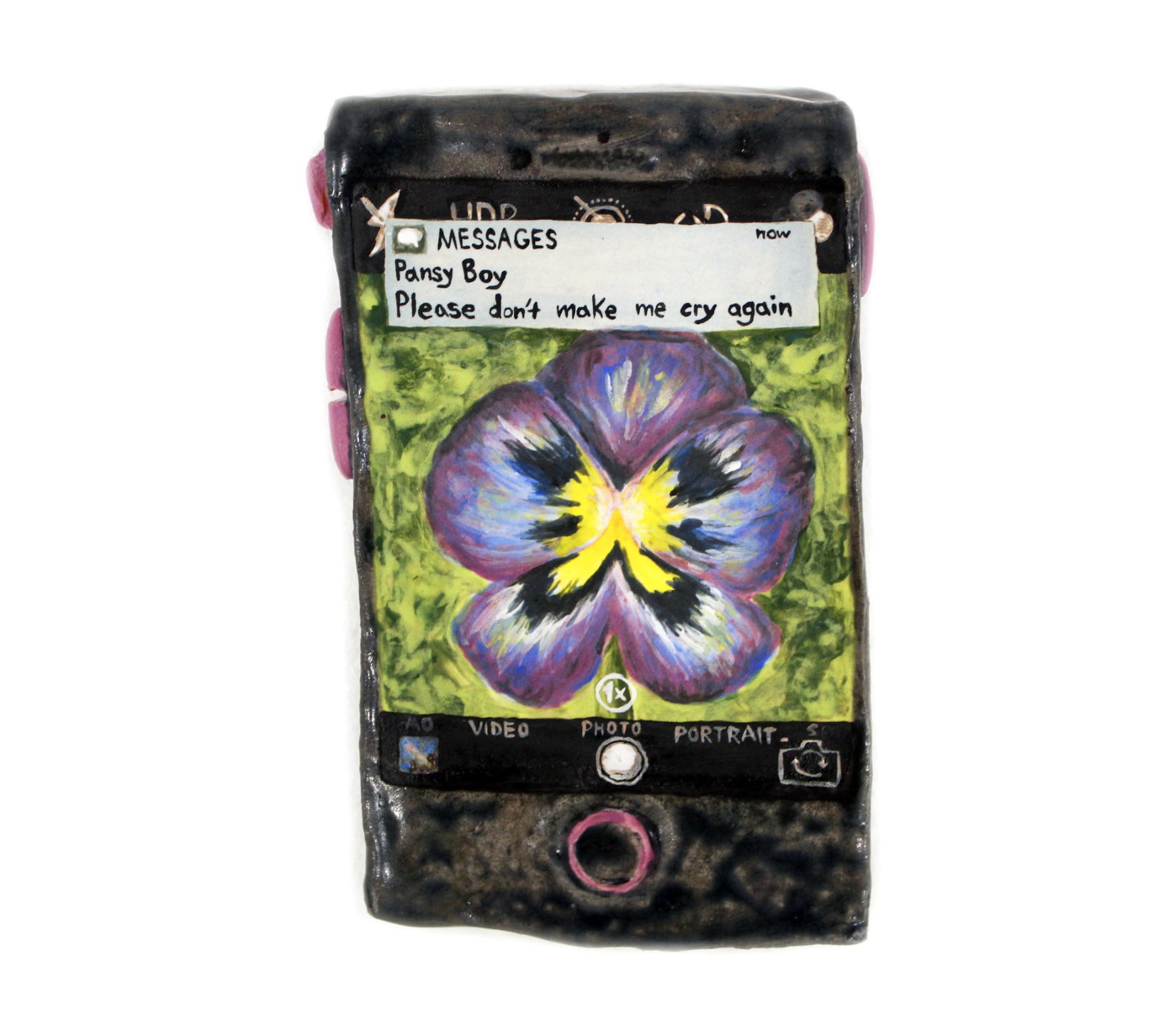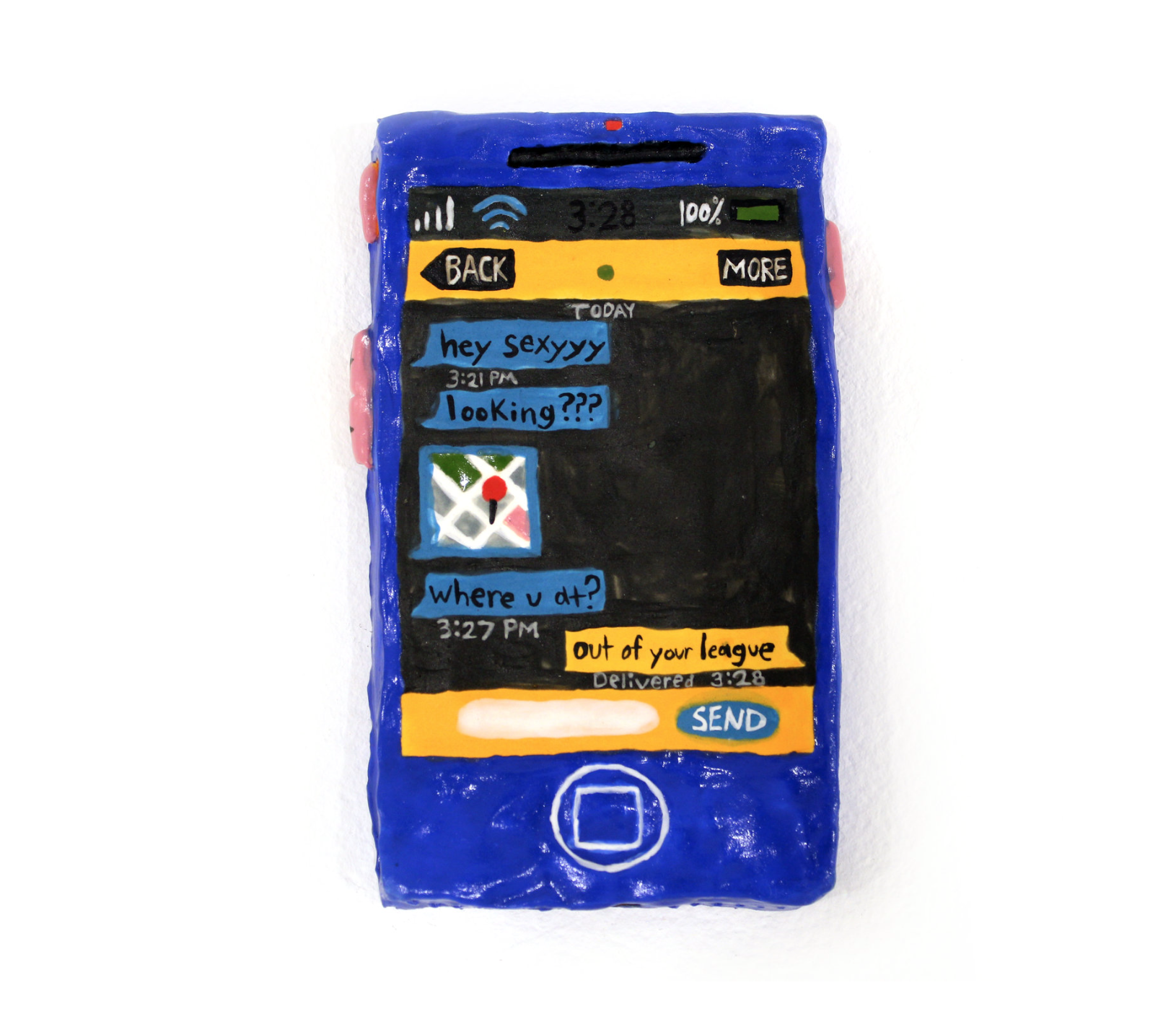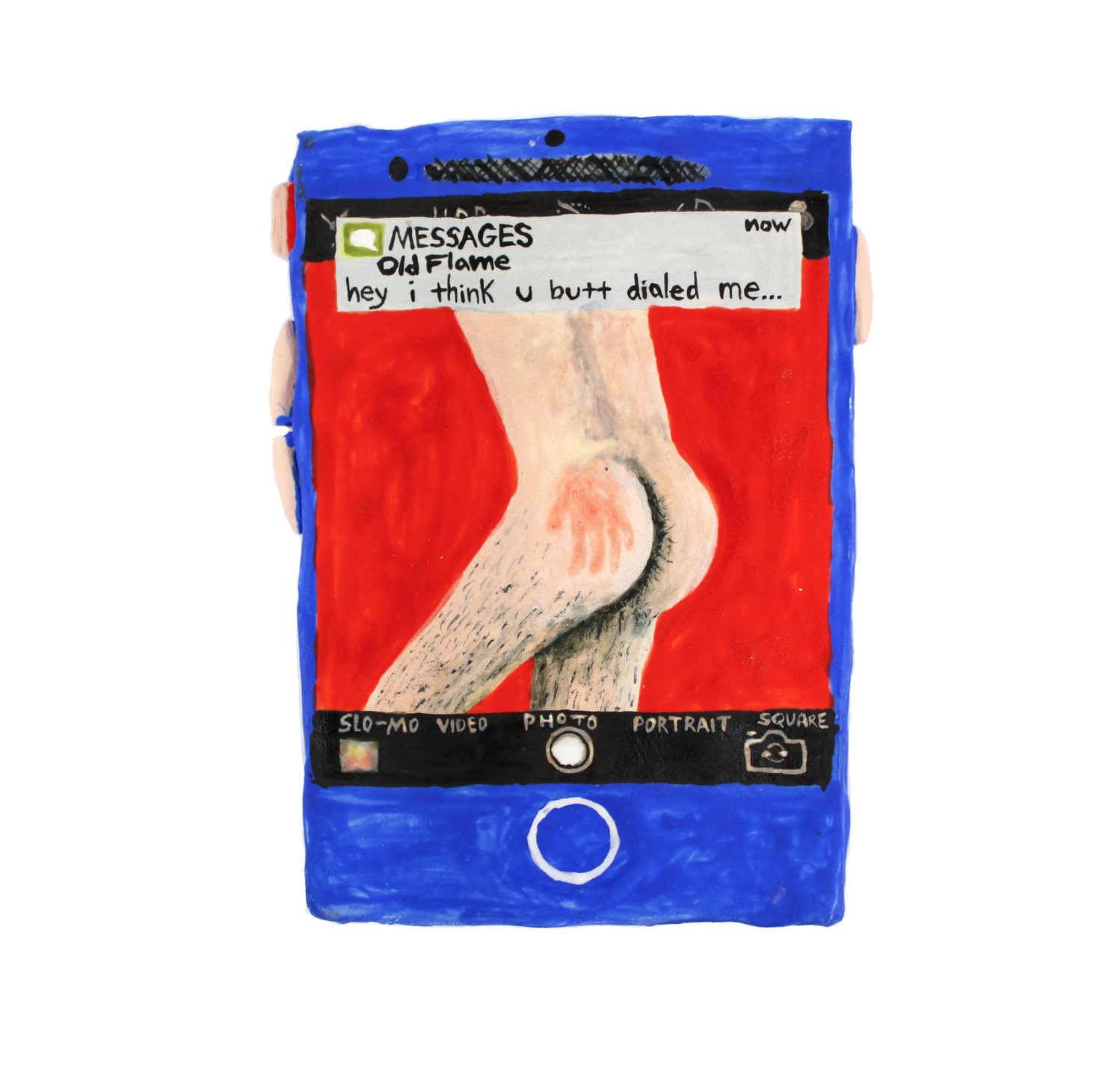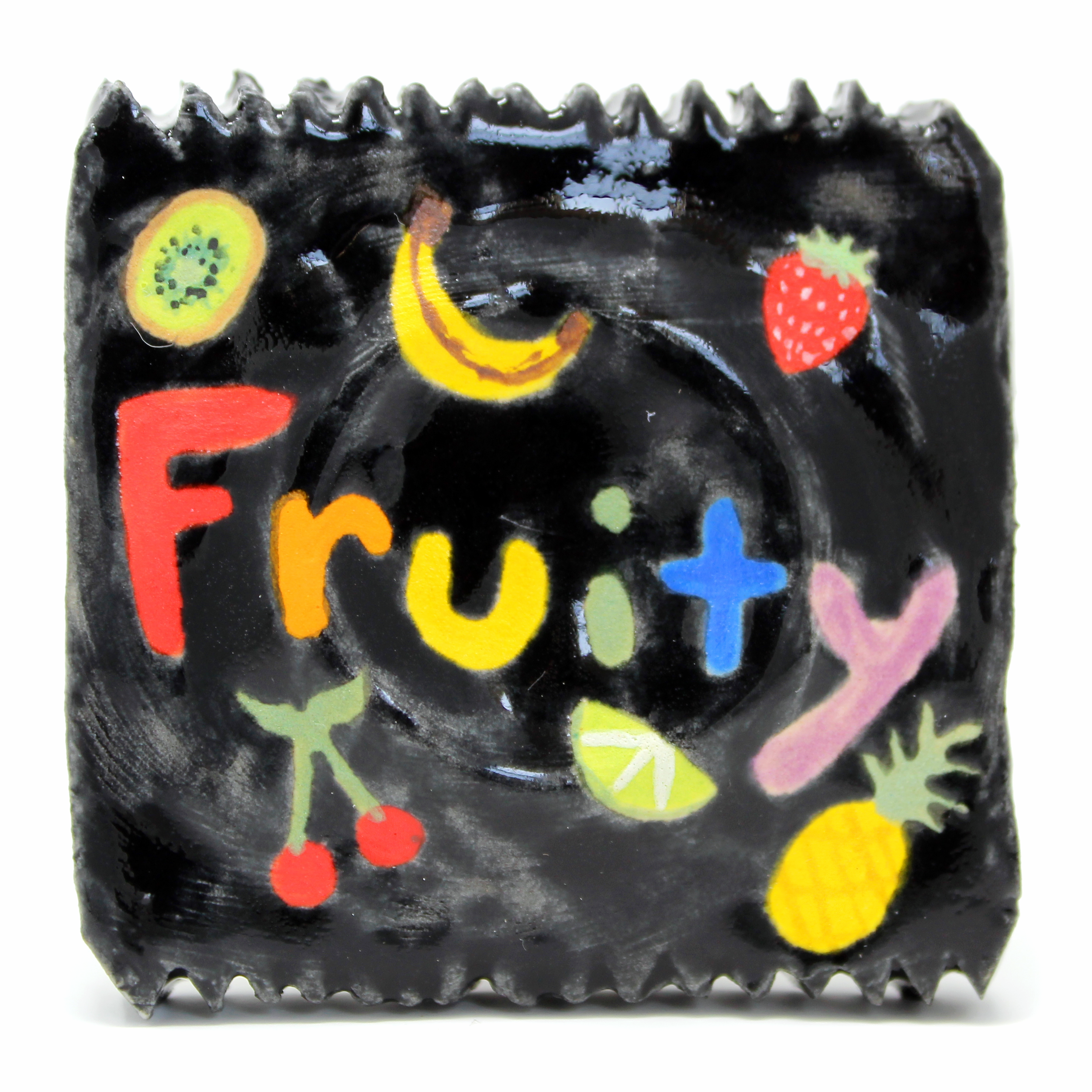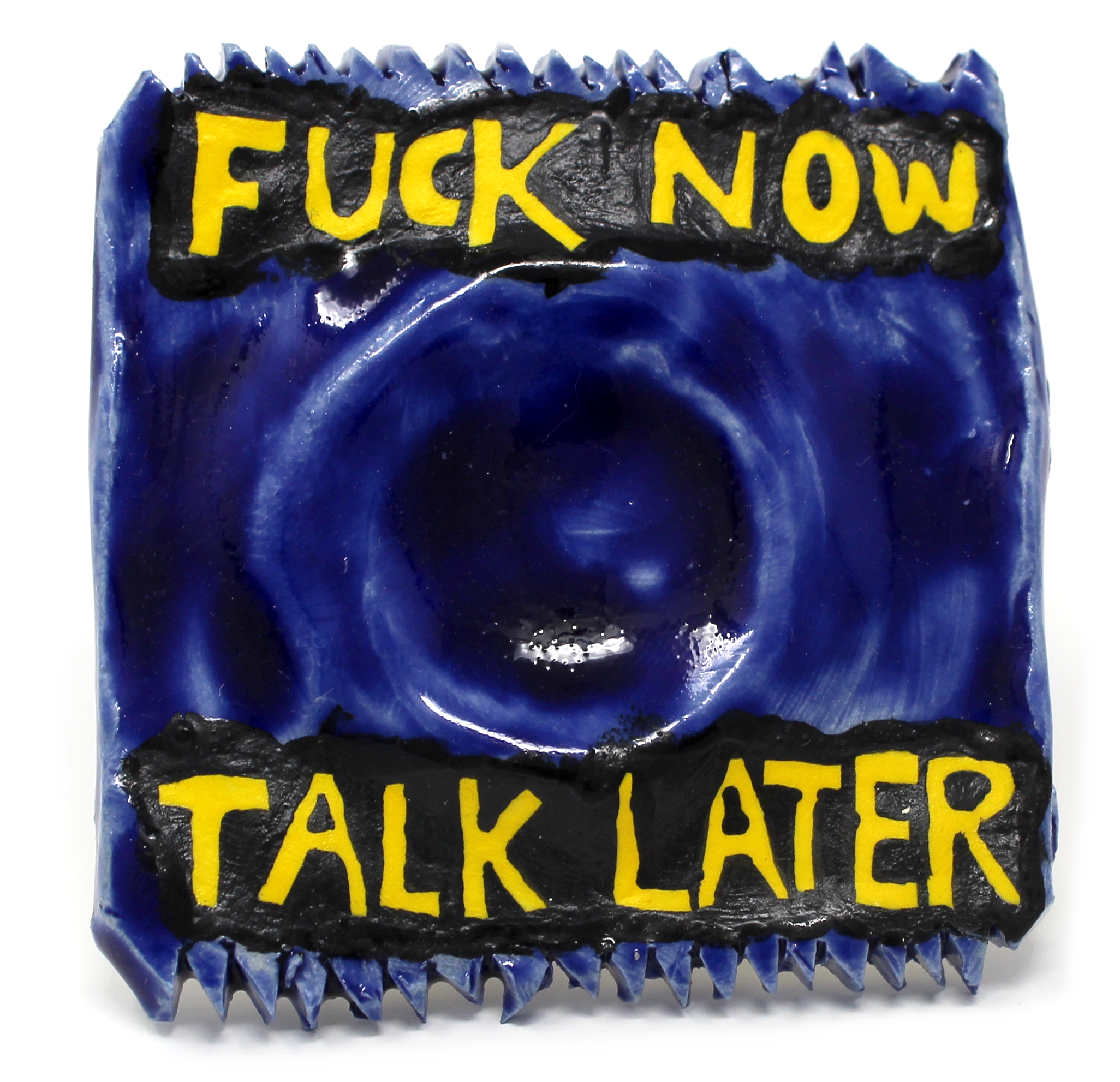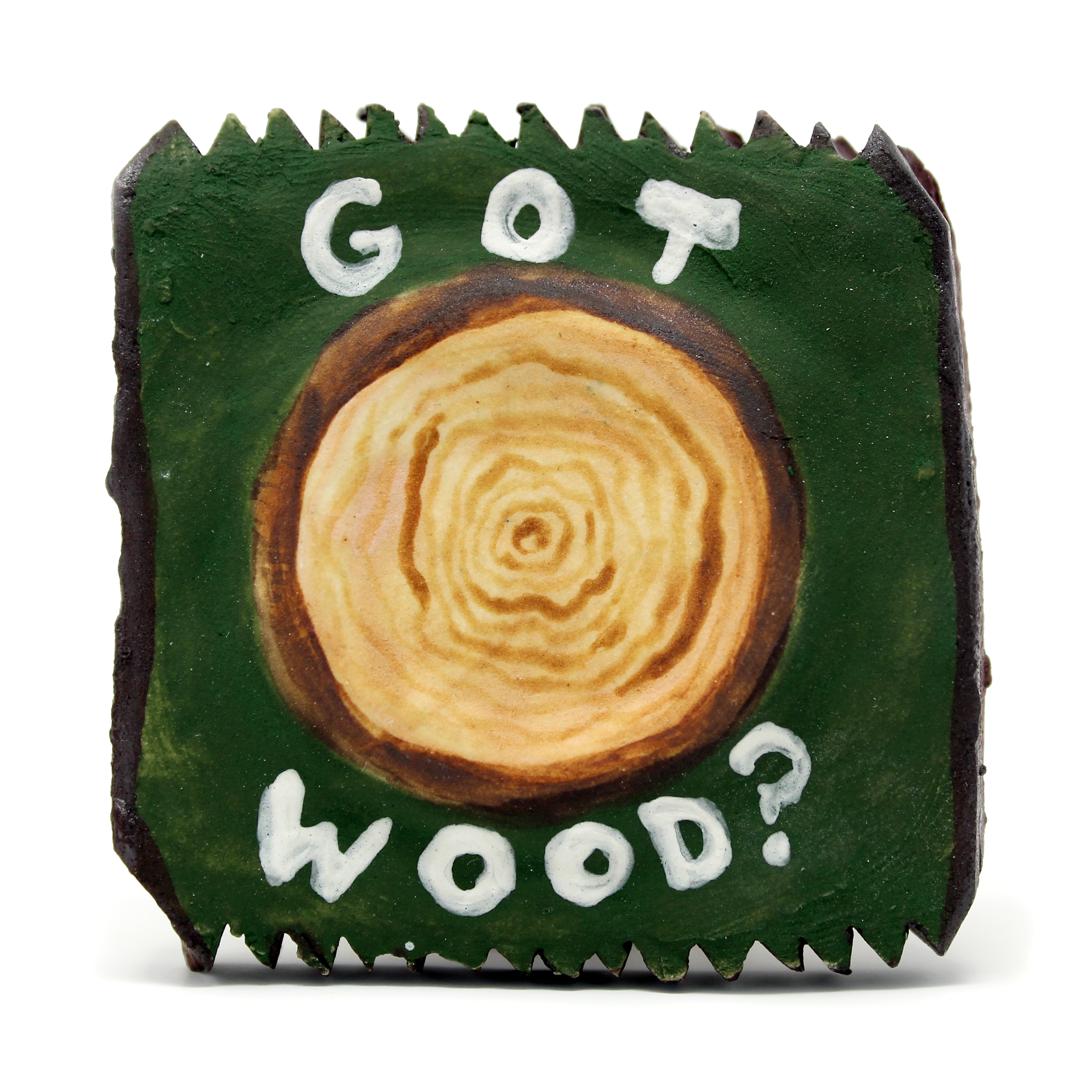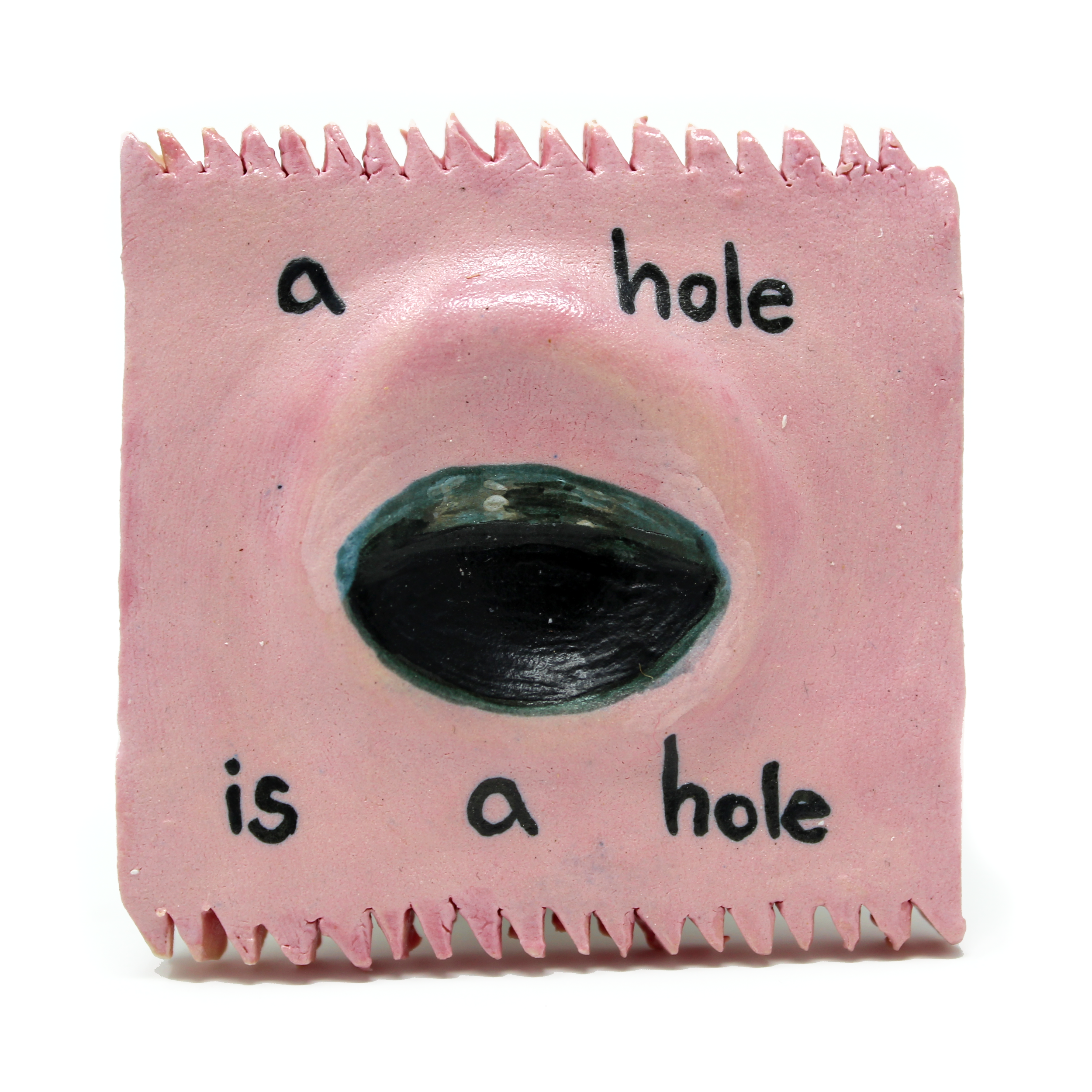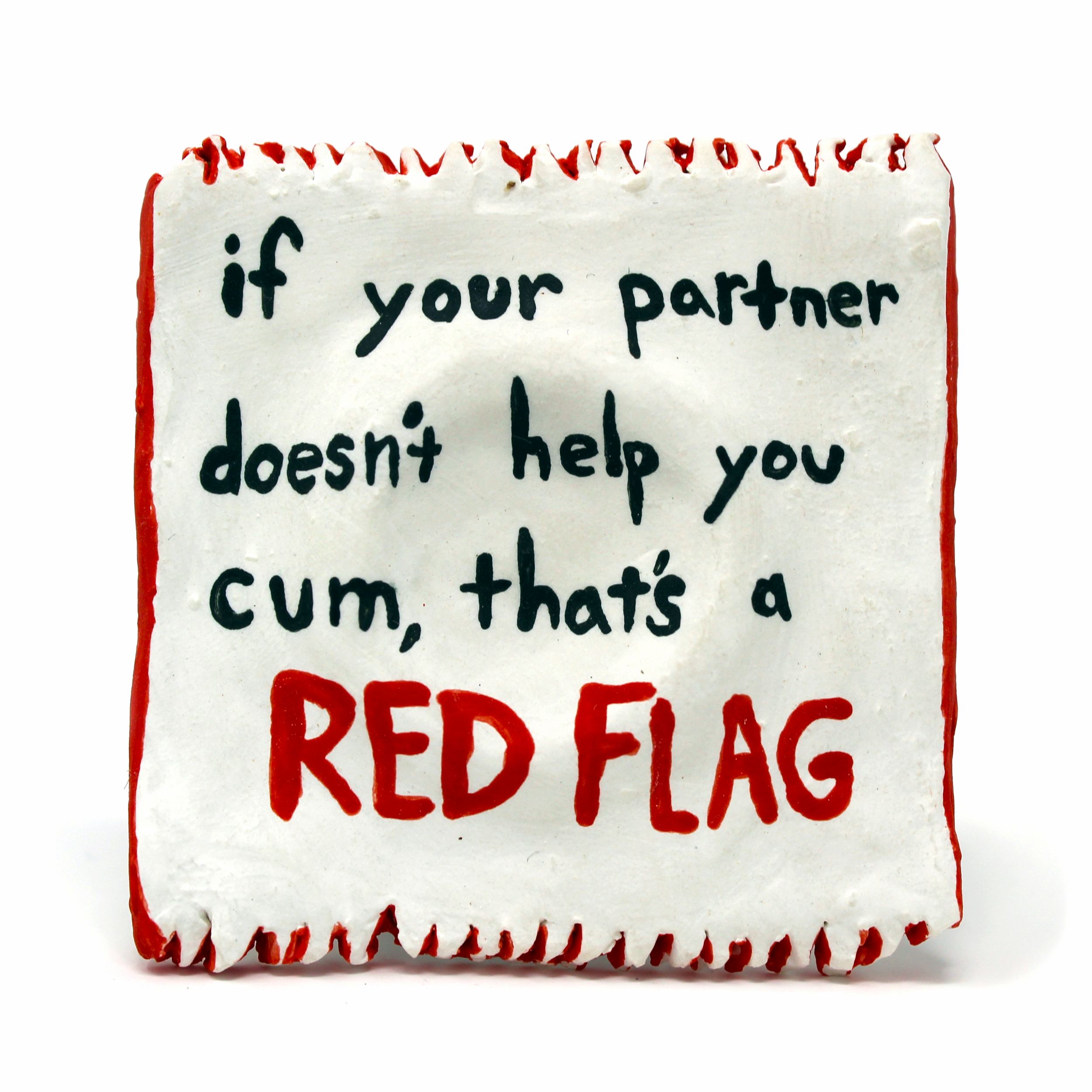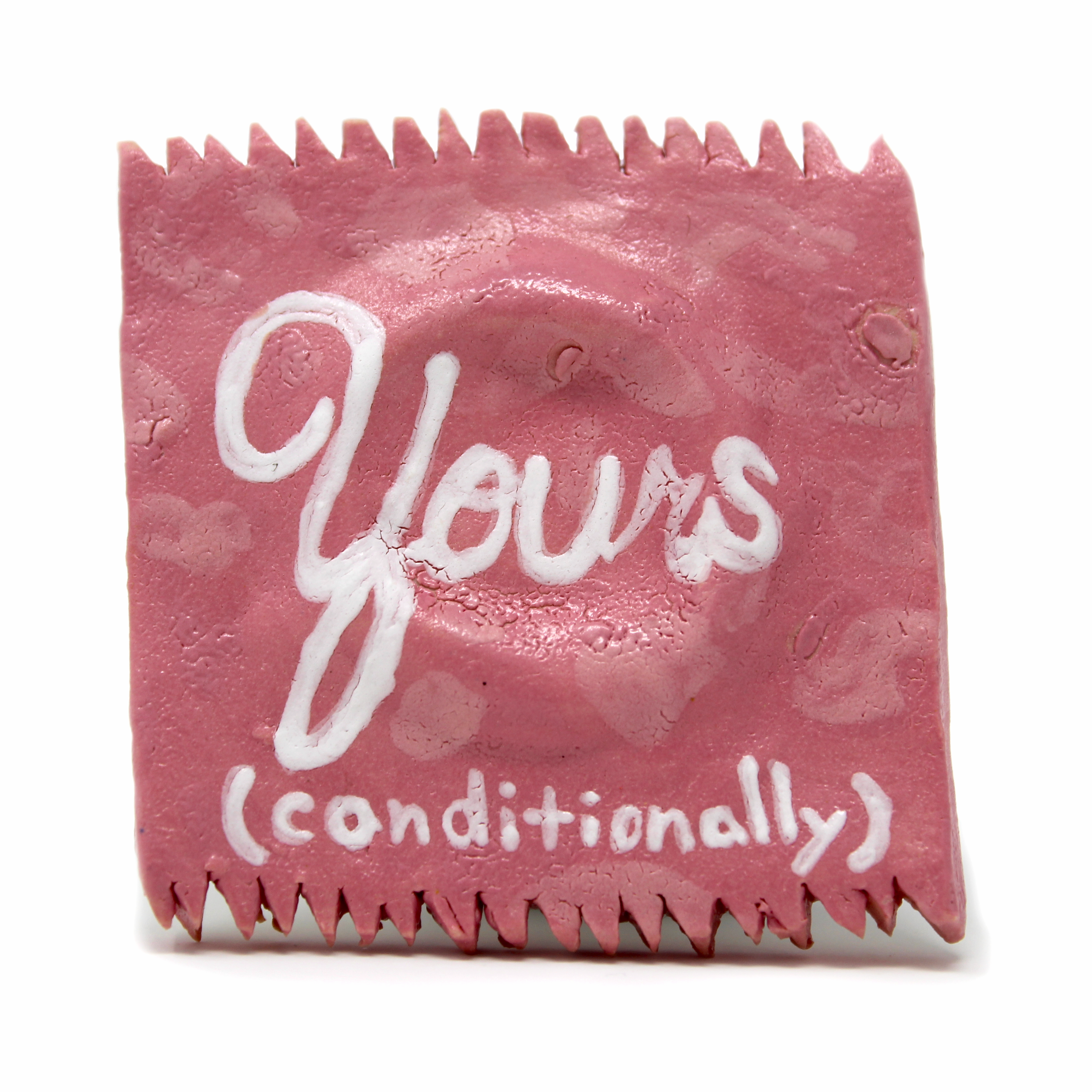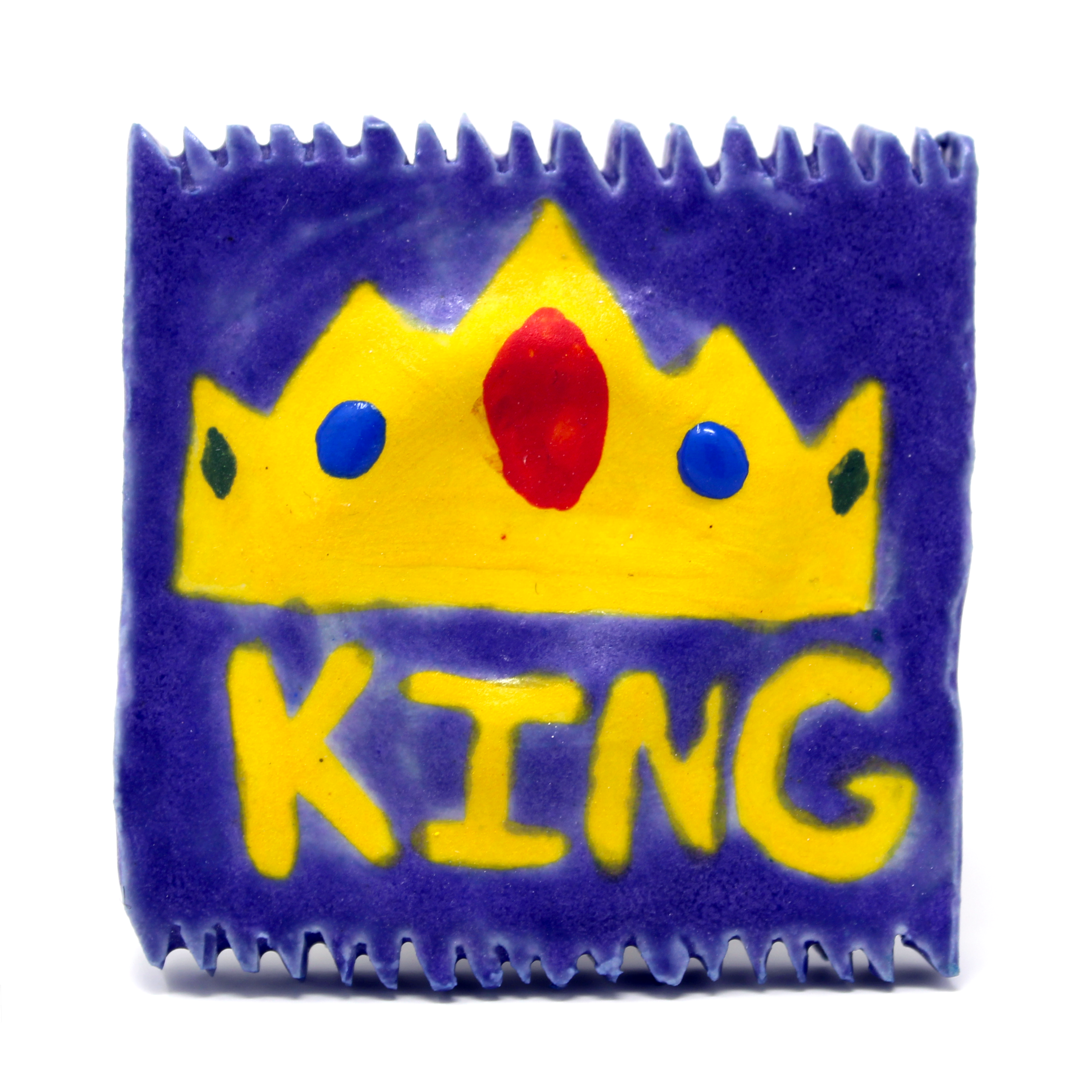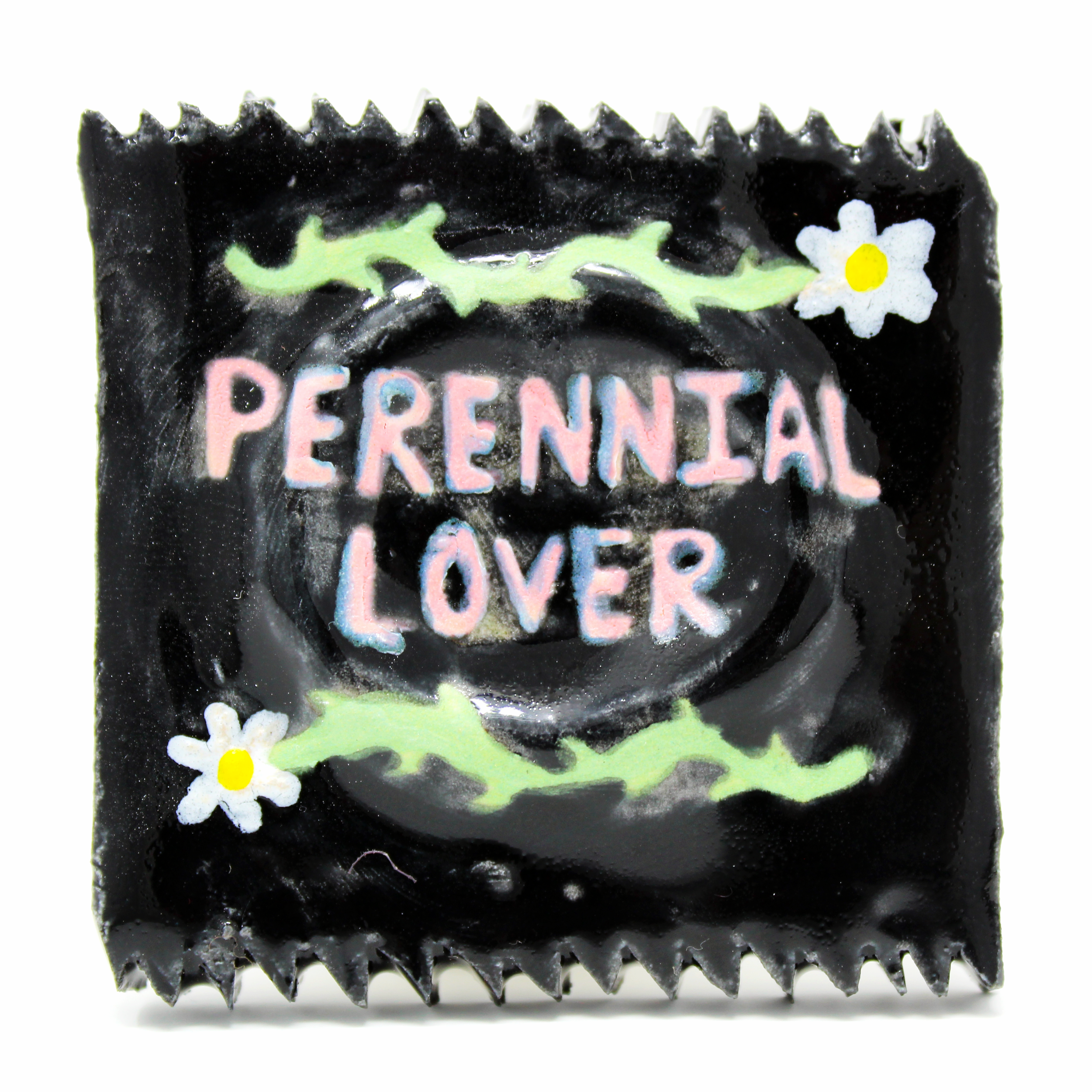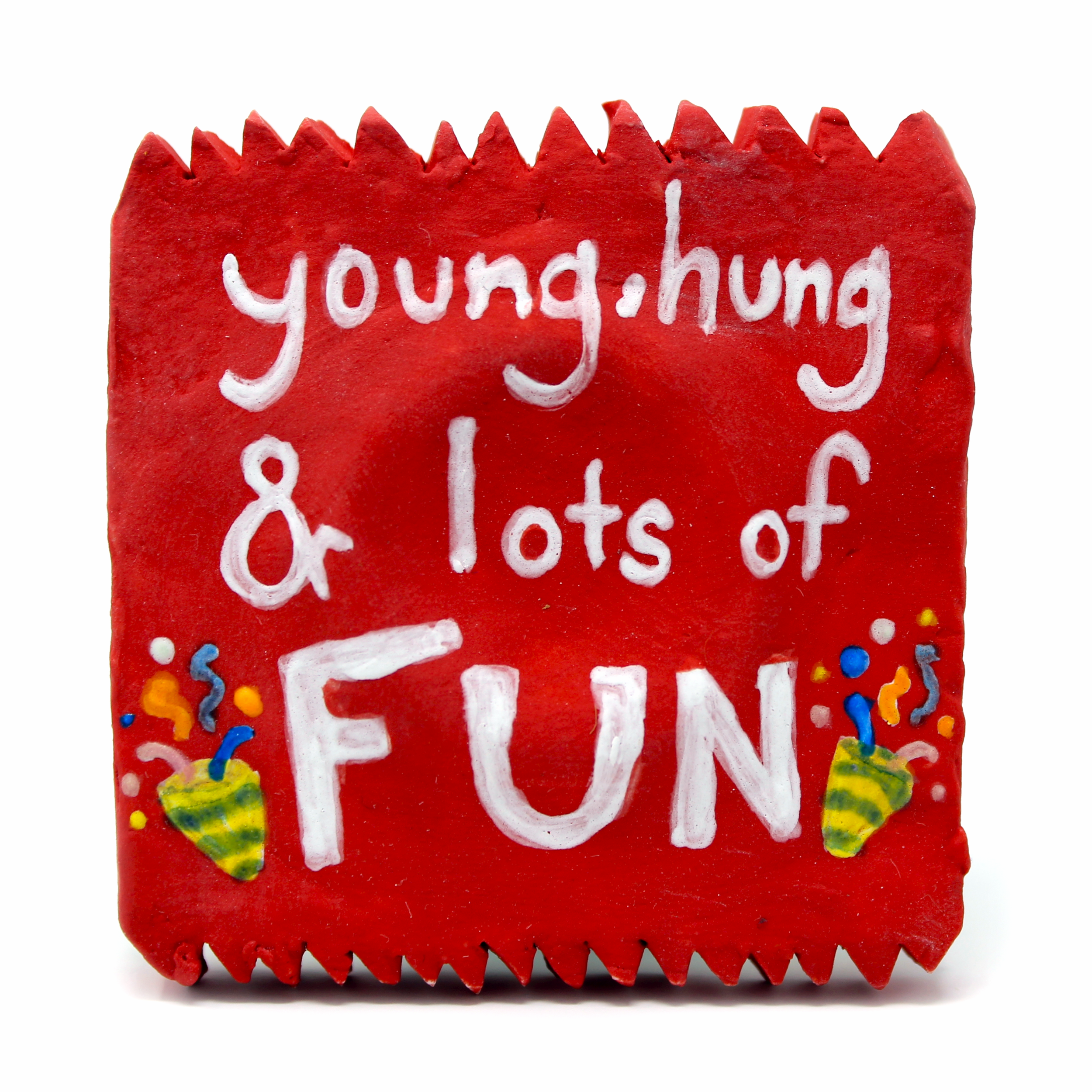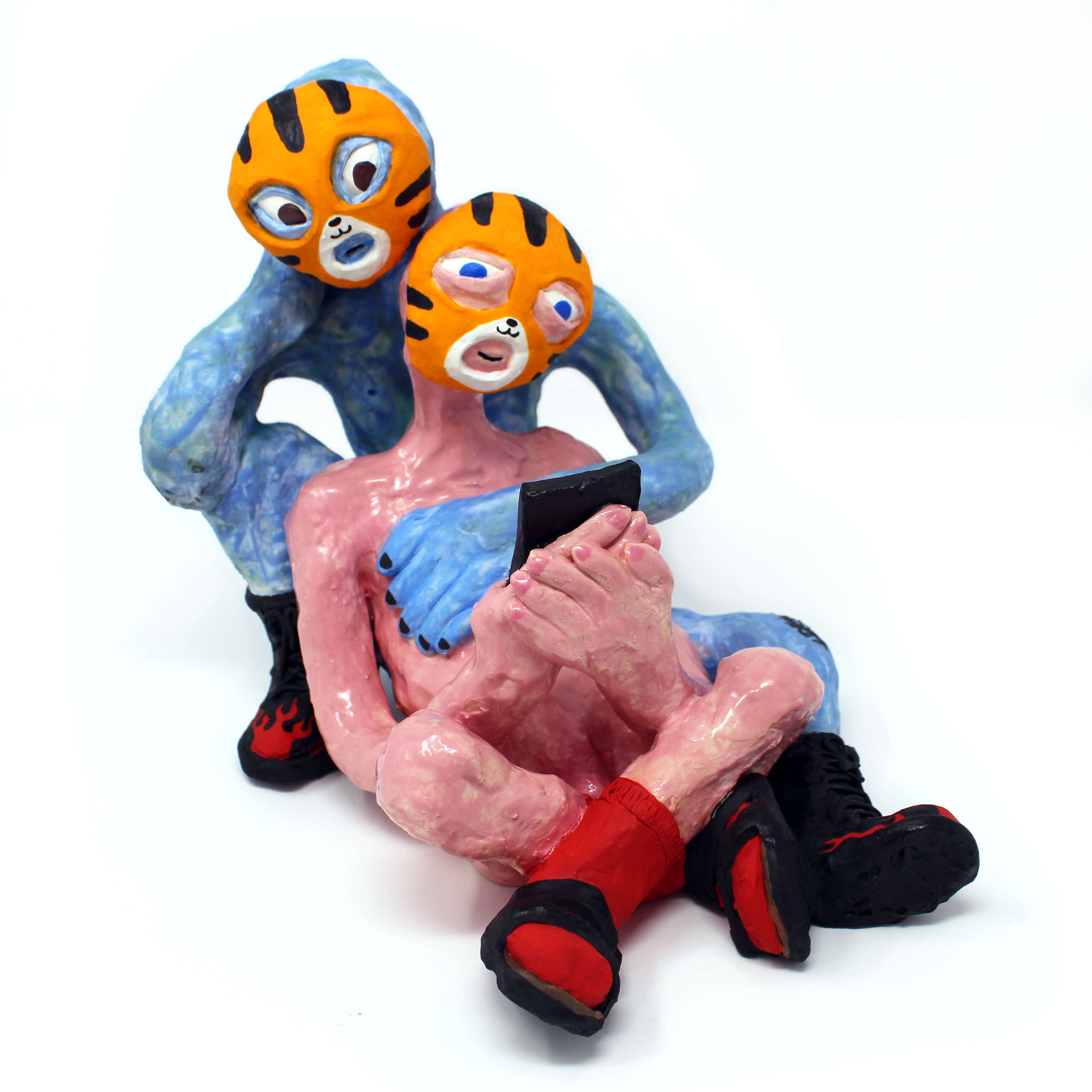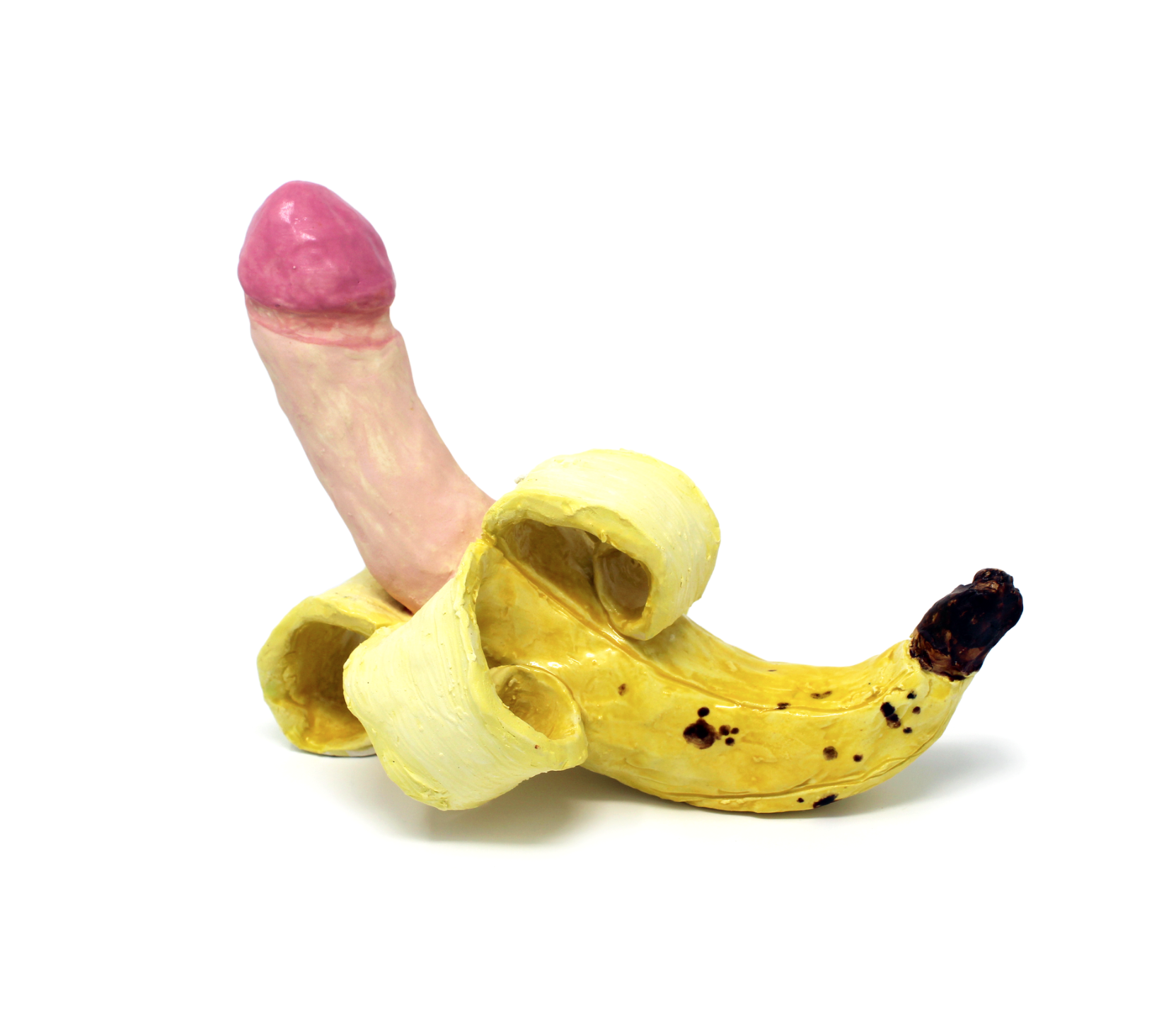
COLIN J. RADCLIFFE
Interview published July 20, 2022
Colin J. Radcliffe is a ceramic sculptor based in Brooklyn, NY. Radcliffe’s figurative and object-based work chronicles his personal successes and failures in Queer love. Centering on the dynamics of homosocializing in Queer digital space, the pursuit of love and intimacy obstructed by a chronically diseased body, humor as a catalyst for healing trauma, and ultimately Queer relationships. Radcliffe’s work has been written about in PAPER Magazine, ARTnews, YNGSPC, MATH Magazine, Gum Gazette, and Arcade Project Zine. Radcliffe has exhibited work in group shows in the US and abroad at Able Baker Contemporary, Flux Factory, Untitled Space, Field Projects, Satellite Art Fair, The Royal Society of American Art, and Villa Noailles. Radcliffe has had solo and two-person exhibitions at SPRING/BREAK Art Fair, Temporary Storage Gallery, and Proto-Gomez Gallery. Radcliffe graduated from Bard College in 2016 with a B.A. in Visual Arts.
Hi Colin! Thanks for joining me for Mint Tea. To begin, what’s your favorite tea? If you don’t drink tea, what kind of coffee or drink do you enjoy the most?
Jasmine green tea, that’s my favorite. I also really like cappuccinos.
Could you tell me about your background and your practice?
Sure: I grew up on Long Island and went to Bard College, I’m 28 years old, I identify as queer, and the kind of work that I make is primarily ceramic-based. It fits into multiple different categories. The primary one is making figures, and the figures are based off of either self-portraits, sometimes lovers or friends that are in my life, sometimes I'll make more than one figure together, cuddling or having sex. And I also make condom wrappers with funny sayings on them, sometimes queer, sometimes just more ubiquitous sex culture. I also make miscellaneous objects like boxing gloves, or medications. And I also make cell phones that have either photos or text that I sent or received on apps. Photos mostly about queer life and dating culture, especially in relation to technology.
What projects are you working on right now?
Right now, I'm trying to make about five hundred ceramic popper bottles as quickly as possible, and a few hundred condom wrappers, and then as many figures as I can make as quickly as possible. I have a solo show on October I'm trying to get ready for, and then collectors want things in the meantime. The show is at a gallery called Schlomer Haus, it's a new gallery in San Francisco. It's in the Castro district, the gay neighborhood.
Colin J. Radcliffe, “Installation View,” 2020, ceramic and glaze
Colin J. Radcliffe, “Lonely Tiger,” 2022, ceramic, glaze, 13.5 x 9 x 8 in.
Colin J. Radcliffe, “Who Wants to Rub Sunscreen on My Back?,” 2022, ceramic, glaze, 13 x 6.5 x 6.5 in.
Tell me more about the five hundred poppers. Are the labels all going to be different?
Almost. I do make a lot of repeats. It's the only type of artwork that I've ever made editions of. The brands that are most common or visually recognizable in New York – like Rush, that’s what most people think of – those I’m making the most of. Then I'm making just a few of other brands that people might not recognize or don't see as often. Sometimes poppers from other countries too, and then a couple that I just invent that sound like they would be a real brand but are just made up.
I am the most familiar with your clay sculptures. Can you talk about how and why you choose to work with the medium that you do?
Oh yeah, I do have very strong reasons for using ceramics. I specifically use porcelain, because porcelain is the most impressionable type of clay. You can literally see your fingerprint in it when you touch it. Clay also has a memory to it, which might sound a little strange, but whichever way you sculpt it, whichever way you bend it – to be a little more technical, all of the particles, the individual sediments of clay within the body of clay itself, will arrange themselves in a new direction. And it doesn't forget that it's been in that direction, or it stays in that direction, so that can create faults, or it holds on to memory, as we say. So if you stretch it a certain way, it's going to remember it's been that way, it's hard to bend it back a different way. So that's one of the reasons – it’s impressionable, it holds on to things.
Clay, and ceramics in general, also has a very long history of being used as vessels and also as idols, little figures or little deities. So it has the history of being some kind of receptive body for emotions, or spirits or ideas that hold on to something. Which is partly why I make ceramics – it’s very cathartic. I get out the emotions that I've had about a relationship or a person, and then there's peace about it. It's physical, and it makes an emotion or another non-tangible thing physical, and then it's out of my body. It's also a record of time in a way that other mediums can be, but ceramics especially, because it's so physical. Particularly certain things that I do, like the cell phones – one hundred years from now, what are people going to think about seeing an object that looks like something that doesn't exist anymore?
Colin J. Radcliffe, “Pickle Lover,” 2022, ceramic, glaze, 12 x 6.5 x 7 in.
How did you begin making ceramics?
I started making ceramics the last year that I was at Bard, my senior year. We had just gotten a kiln and I was one of the only people using it, and that's what became successful for me, and what people were interested in. So I kept making that after I graduated, and then it just took off from there. For me, ceramics feels like the one medium that I'm able to communicate most effectively through, or most honestly. I actually say what I want to say, as opposed to with painting or sewing. Ceramics is kind of the opposite from painting or drawing. It's more similar to printmaking in that it's so unpredictable. You don't know what color your piece might actually be. You don't even know if it's going to blow up.
What is your creative process like? Do you start with a clear vision of the final work or do you let the clay guide your way?
A majority of the time, the work comes from a personal experience. I go into the studio with an idea of what I already want to make. The work comes from my own relationships, so relationships that I have with other people, platonic, sexual, or romantic, then will lead to a piece. Not always, but most of the time. Sometimes I'll make multiple pieces about one person or one relationship, but it really depends. The clay itself sometimes will dictate the form or the pose, because you have to fight gravity. Clay is very malleable but it's also very impressionable, so it can sometimes be a little difficult to get it to cooperate.
Do people ever recognize themselves when you make them into art? What do they feel about it?
You know, it actually does depend. Most of the time I let people know, like, “Hey, I made a piece about you, surprise!” Or I tell them while I'm working on it or even before, like, “Hey, I think I'm going to make something about you. I don't know what it's going to be yet, but I'm interested in working from this experience.” Sometimes I make a piece about someone and I don't tell them, because it's maybe not a positive piece about that person. But they'll know that it's about them. Whenever I make a figure about a particular person, I always include details that are referential to that person and that experience, so that they will see that piece and click, “Oh, that's me…” Or people that know them will also recognize it. If you know who a person is or what their identifiers are, sometimes my pieces will be very obvious, especially if you live in the same neighborhood that you've dated people in, then you will run into them.
Colin J. Radcliffe, “You're Not Dead, but You're Dead to Me,” 2021, ceramic, glaze, 4 x 4 x 6.5 in.
Colin J. Radcliffe, “Respect the Dead, Move On,” 2021, ceramic, glaze, 14 x 9 x 3.5 in.
Colin J. Radcliffe, “Respect the Dead, Move On,” 2021, ceramic, glaze, 14 x 9 x 3.5 in.
Could you talk more about the ceramic figures? Do they function as self-portraits or are they something else?
Sometimes they are self-portraits, other times they are versions or depictions of lovers that I've had, or friends. So nine out of ten times they're based off of an individual that I know personally or had a relationship with. Then I'll include details of that individual on a piece. Like if a person has a tattoo, or a birthmark, or some kind of motif like a sunflower or gold chain or something distinctly them.
From a third-party point of view, it can be hard to tell which pieces are self-portraits and which ones are not. Is there something you make sure to include in your work when it is meant to be a self-portrait?
As of 2022, yes. I had – not necessarily an epiphany, but a moment where I felt like I needed to be even more honest with the work that I was producing. The easiest way to do that is to be more referential and more direct. So all of the new pieces I’ve been making that are self-portraits are very clearly me. Usually hair color is the biggest giveaway, because I change my hair a lot. Sometimes what I've done, on Instagram in particular, or for a collector that's purchasing work, I’ve sent them a reference photo or video they can see, “Oh, this is you, or this individual, or you and a partner. This is about you.” I might actually print out photographs for the solo show to put up alongside them.
Is your attitude towards manipulating the clay different when you make work that is self-portraiture instead of depicting a partner?
I would say the experience of making a ceramic figure is not drastically different between making a self-portrait versus one of a partner. The emotions are very different. I mean, a big driver for why it makes sculpture is because it’s cathartic to get some feelings out.
Can you talk about any imagery or symbols that you like to work with?
Very generally speaking, gay paraphernalia. Condom wrappers, popper bottles, dicks, also Truvada, which is what we call PrEP. It's a medication that a lot of gay people take, or people who have sex with men, because it prevents HIV. In terms of general images or motifs, it really varies a lot between individual pieces. I use those motifs as indicators or references. So, there's one person that I dated for a year that loves sunflowers, so sunflowers show up in that individual piece. For myself, there’s a piece I did very recently that has me on a tiger rug wearing a tiger mask. I have a tiger rug, and I love those animal face masks. There was a piece I made of someone I dated and me where we both wore tiger masks, a piece of both of us together. So those kinds of references and motifs come up.
Colin J. Radcliffe, "Send Nudes (on a Nokia)," 2019, ceramic, glaze, 0.5 x 2.5 x 5.5 in.
Colin J. Radcliffe, "Banana Dick," 2019, ceramic, glaze, 0.5 x 2.75 x 4.75 in.
Colin J. Radcliffe, "Text from Sweetheart on a 2004 Razor," 2019, ceramic, glaze, 1.75 x 2 x 6.5 in.
Colin J. Radcliffe, "Pansy Boy," 2019, ceramic, glaze, 0.5 x 2.75 x 4.5 in.
Colin J. Radcliffe, "Out of Your League on Grindr," 2019, ceramic, glaze, 0.5 x 3.25 x 5.5 in.
Colin J. Radcliffe, "Hey I Think U Butt Dialed Me...," 2019, ceramic, glaze, 0.5 x 3 x 4.5 in.
Colin J. Radcliffe, "You Only Ever Want to See Me After Midnight," 2019, ceramic, glaze, 0.5 x 2.75 x 4.5 in.
Colin J. Radcliffe, "Missed Call from Mom," 2019, ceramic, glaze, 0.5 x 2.75 x 4.5 in.
What is the significance of phones and technology in your work?
A few years ago, I realized I was extremely dependent on my phone, and rely on it for forming relationships with other people in particular. I felt like well, if this is the main mode of communication, or the initial instance of me forming a relationship with another person, why is that not a part of the work that I'm making? So I started making cell phones. Some of them are more like jokes and tropes of dating culture, or queer culture, particularly in relation to social media and technology, like Tinder, Grindr, Instagram, Snapchat. I have just been feeling that it was an important or integral step for me personally and for my work, to be more honest in making work about where those relationships come from, and kind of critiquing or evaluating or even just archiving how people communicate through digital space. Especially socializing in queer digital space, because it is pretty different. And I had been thinking also about physical queer spaces, like gay bars, or how people would cruise. At least in New York, cruising, it does exist for sure, but not in the way that it did in the 70s or 80s, 90s, even early 2000s. It doesn't – you can't go to a park or go to certain parts of the park and expect there to be guys that are waiting. Today the way people meet is through Grindr mostly, so I felt like it was important to record that.
What inspires the text that you incorporate into your sculptures?
It comes from a few different pieces. One of them being personal experience, so things people say to me or that I say to other people, especially through technology, through social media, or apps like Grindr. The other place that it comes from is just sex culture and queer culture in general – jokes and tropes, phrases that people use. And then some things are invented. Sometimes when I invent things, like whether it's a condom wrapper or a phone, I'll make ones that are almost diaristic – diary entries trying to get out a certain feeling, or things that I wouldn't otherwise say to someone, or that I do feel. Sometimes they can be a little petty, but you know, that's part of everyone's experience. I think when you get upset with the way something went, you have something to say about it. That's why art therapy is a thing.
Colin J. Radcliffe, "Fruity," 2022, ceramic, glaze, 2.5 x 2.5 x 0.25 in.
Colin J. Radcliffe, "Fuck Now Talk Later Condom," 2021, ceramic, glaze, 2.5 x 2.5 x 0.25 in.
Colin J. Radcliffe, "Get Tested," 2022, ceramic, glaze, 2.5 x 2.5 x 0.25 in.
Colin J. Radcliffe, "Got Wood?," 2022, ceramic, glaze, 2.5 x 2.5 x 0.25 in.
Colin J. Radcliffe, "Spicy! Hot! Sexy!," 2022, ceramic, glaze, 2.5 x 2.5 x 0.25 in.
Colin J. Radcliffe, "Hung," 2022, ceramic, glaze, 2.5 x 2.5 x 0.25 in.
Colin J. Radcliffe, "A Hole is a Hole," 2022, ceramic, glaze, 2.5 x 2.5 x 0.25 in.
Colin J. Radcliffe, "If Your Partner Doesn't Help You Cum, That's a Red Flag," 2022, ceramic, glaze, 2.5 x 2.5 x 0.25 in.
Colin J. Radcliffe, "Yours (Conditionally)," 2022, ceramic, glaze, 2.5 x 2.5 x 0.25 in.
Colin J. Radcliffe, "It's Not Me It's You," 2022, ceramic, glaze, 2.5 x 2.5 x 0.25 in.
Colin J. Radcliffe, "King," 2022, ceramic, glaze, 2.5 x 2.5 x 0.25 in.
Colin J. Radcliffe, "Not Your Baby," 2022, ceramic, glaze, 2.5 x 2.5 x 0.25 in.
Colin J. Radcliffe, "Perennial Lover," 2022, ceramic, glaze, 2.5 x 2.5 x 0.25 in.
Colin J. Radcliffe, "Post Nut Clarity," 2022, ceramic, glaze, 2.5 x 2.5 x 0.25 in.
Colin J. Radcliffe, "Young Hung & Lots of Fun," 2022, ceramic, glaze, 2.5 x 2.5 x 0.25 in.
What is the role of humor in your work?
I love humor. For me, humor is the easiest way to talk about difficult subjects. It's the most comfortable way to talk about trauma. One of the critiques that I would get a lot with my senior project in undergrad years ago, was to pick a lane, more or less. Like, either go all the way and make things that are just cute and fun fully, or make things that are dark and sad fully. Like, why are you doing things that are both at the same time? But that's just how I feel all the time. Everything's ambivalent, things are good and bad, sometimes at the same time, and I feel like especially now that I've maybe come more into my own work or feel more self-actualized or more confident, that feels more like a strength to me than anything. It's more wholesome.
What are your favorite colors? Do they find their way into your artworks?
Consistently. Baby blue and pink are very common. Also red, intense punchy red. Those colors come up with the most often, blues, pinks, reds. Orange, the least, it's my least favorite color. But you know, sometimes you’ve got to use it. It's one of the hardest colors to mix and keep its integrity. It's really easy to make it look dirty. I also just feel like orange is overrated, in my personal feeling. I think other colors carry more weight or more substance for me, or at least are the language that I like to communicate in more. Pinks, blues, reds.
Chemistry is really important with ceramics. The color that it looks on the piece before it's fired, very often is not the same color after. And that's part of the beauty of ceramics, is it's so experimental and so unpredictable, like love, which is what I make work about. Trial by fire, literally. I pretty typically use commercial glazes more than anything, because they're more stable and more predictable. But sometimes something called off-gassing happens in a kiln, where because of the gases coming off of the glaze that’s being fired on a different piece, those gases are in the same environment in the kiln, they will affect the surface color of your glaze. So even if you fire the same glaze, same temperatures, same settings, everything, the color could be different from piece to piece and from firing and firing. And the method of firing also changes the color.
Is there a new medium that you would like to try or to work in more?
Yes, actually, I want to try 3-D printing with ceramics. So if anyone has the magic code, I'm ready. It's not too many people that have 3-D printers, and very there's much less that can handle ceramic 3-D printing. But they exist. I don't really know what I would make, except maybe popper bottles. That'd be really nice, commercialize them a little bit. But part of part of my big draw with making ceramics is that they are hand built. I don't really use that many tools. You're impressing your emotion or feeling or some intimate memory experience through touch. The same hands have touched a lover are touching the clay.
Colin J. Radcliffe, “João and Colin,” 2021, ceramic, glaze, 7.5 x 9 x 8 in.
Colin J. Radcliffe, “João and Colin,” 2021, ceramic, glaze, 7.5 x 9 x 8 in.
Colin J. Radcliffe, "Leo the Leo," 2022, ceramic, glaze, 11 x 5 x 5.5 in.
Colin J. Radcliffe, "Uncut (Banana Dick)," 2021, ceramic, glaze, 9 x 5.5 x 6.5 in.
Colin J. Radcliffe, "Taking Out the Trash (You)," 2022, ceramic, glaze, 5 x 8 x 7 in.
Where are you located now? Do you think where you are located influences your practice?
I'm pretty independent in a lot of ways, but I do think everything, especially your environment will influence the kind of work that you make, or are open to making. Your experiences directly affect the end product. It's very easy to meet people in my neighborhood, so the basis of my work is very easy to come by. I live in Bushwick, around a lot of young gay people. It’s very easy to meet people. Everyone's on the apps. I am about to move to Astoria, which is more residential and more family oriented, so more quiet, but a lot closer to my studio. I feel like just living anywhere in New York, it’s still very accessible to have any kind of experience that you're looking for. Everything is here at all times – it’s a city of convenience. So yeah, I think living in New York influences me generally, and specifically Bushwick has been pretty influential.
How do you stay connected to your community?
I'm very much a one on one person. I feel like I connect better with people and perform better socially in one on one scenarios or environments. I do go to openings, but typically only if there's work that I want to see and there's people that I know I want to see that are going to be there, or friends have invited me. I also really liked doing studio visits, which are almost always one on one, and those are always exciting and very engaging. Because you're getting to see one, a person that you like and are interested in, two, artwork that you're interested in. And then you have conversations about art opportunities, almost networking, I am very against networking as a general thing in the art world. I think it's very close to social climbing, because the art world is a social career, and I think it's more important to establish healthy relationships with other artists and other art world professionals than just to seek out or find a career, because that's not sustainable, or right.
What’s your favorite tool?
My phone. Yeah, most useful, most practical, I use it most regularly compared to anything. It leads to the creation of new work for me. It's like truly the most useful tool for me.
I've thought about this so much, and it's honestly an extreme existential crisis that I have all the time. That, like, my life is my work and my work is my life – how do I deal with that? And then I think, “Oh my gosh, am I being driven to meet people because I make work about it? Or am I making work because it’s a way to meet people?” Which is a whole chicken or the egg situation, what's driving what. But I had a professor in college that told me, you know, one thing that all artists experience and have to be acutely aware of, is you should not feel guilty about not producing artwork consistently or all the time. You don't have to be productive physically in the studio every day to be a successful artist. Because your experiences intellectually, socially, emotionally, spiritually, everything outside of the studio that is not physically producing work is leading to the creation of work, and that's an important part. You have to live your life – your life is the first thing that happens. Art doesn't happen without life so go live it.
What is the space where you do your work?
Where I physically produce work is a ceramic studio, more of a facility or shared space. I have my own private storage area where I keep works that are in progress, but everyone works communally out in the open at tables, sharing space with other people. So it's a very dynamic, very social atmosphere. There are very few artists at my studio, almost everyone's a potter making pots, bowls, cups, mugs, that kind of thing. The demographic of the people in my studio is very different. There are only a couple other people that I know are gay or queer – most people are much older, 60 and up, retirees, and most of them are women. So there's usually some interesting interactions with them and the work that I make, but for the most part everyone seems to enjoy what I'm doing, which is nice.
Do you have any ritual that helps you get into the zone?
I don't know if I necessarily have a ritual. It's not really a ritual, but the best work, or the work that I feel strongest about usually has the strongest emotions driving the creation of it. So feeling really intensely about something, then I go and make something.
Colin J. Radcliffe, “I Poured Everything I Had into You (But It Was Never Enough),” 2021, ceramic, glaze, 9 x 7 x 7.5 in.
When do you know when you are finished with your artwork or a body of work?
When it feels natural. It's a little tricky because ceramics, in some ways, are extremely immediate, your touch directly translates to what physically is present. But the process is much longer for it to be completed, and it’s in steps. So you have the physical sculpting of the piece, which is the most immediate. And then there's the drying phase, which can take weeks, sometimes months, depending on the piece. And then you fire it once, and it's bisque fired and ready to be glazed. And then you glaze it, and the end result can be unpredictable in terms of color.
I guess each piece is pretty individual. Maybe it fits within an overarching concept or theme, but I never work with something in mind like, “Okay, this is going to be about this niche area of queer culture.” It's much more general, and because it's personal and also a record of time in our relationships, those things are very natural, and from piece to piece, things will change very slowly, very incrementally. So I don't necessarily feel like I'm ever finished with a concept or that there's a point in making something where I'm done with that concept, because it bleeds into the next piece and the next one, and then maybe it actually gets so diluted that it’s not in my work. But for the most part my work is all within the same atmosphere of subjects.
Who are your favorite practicing artists?
Oh, too many. It changes from time to time, there's always new ones that I find out about or that I fall back into love with. But the ones I think about most consistently or currently are Tracey Emin. In particular, she made a piece that is usually called the tent. She made this cloth tent, and then on the inside she embroidered the names and dates of all of her lovers and boyfriends. Yeah, I identified with that. Justin Liam O'Brien who's a queer figurative painter in New York. Jody Paulsen, who makes these giant felt collages about pop culture, and sometimes, queer culture. He’s based in South Africa. Ben Orkin, who is a ceramic artist who makes abstract ceramic vessels, about queer bodies and queer relationships. So kind of related to what I do, but more abstract. Those are the ones that come to mind immediately.
What gives you the feeling of butterflies in your stomach?
Hmm… well, a cute boy…

